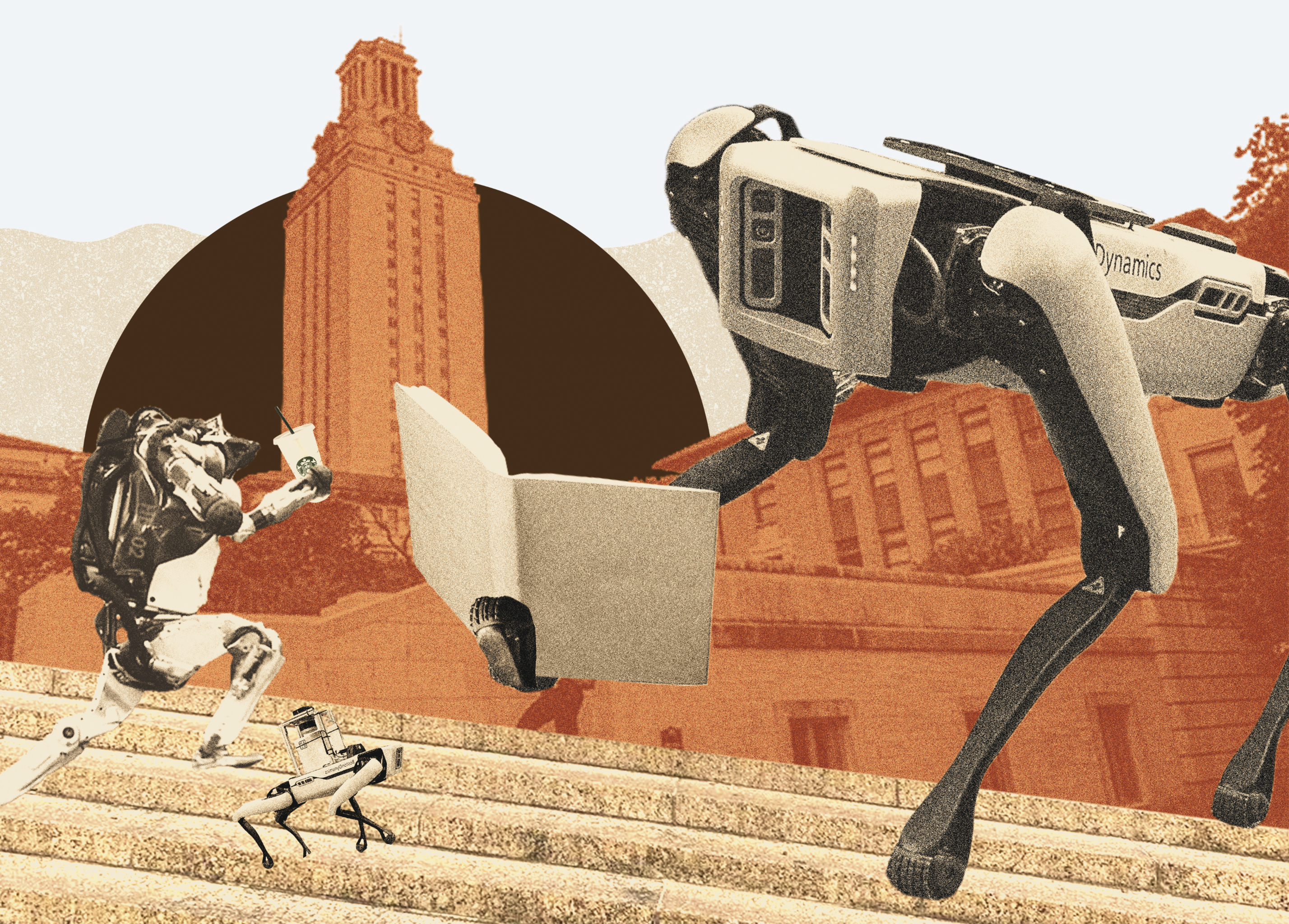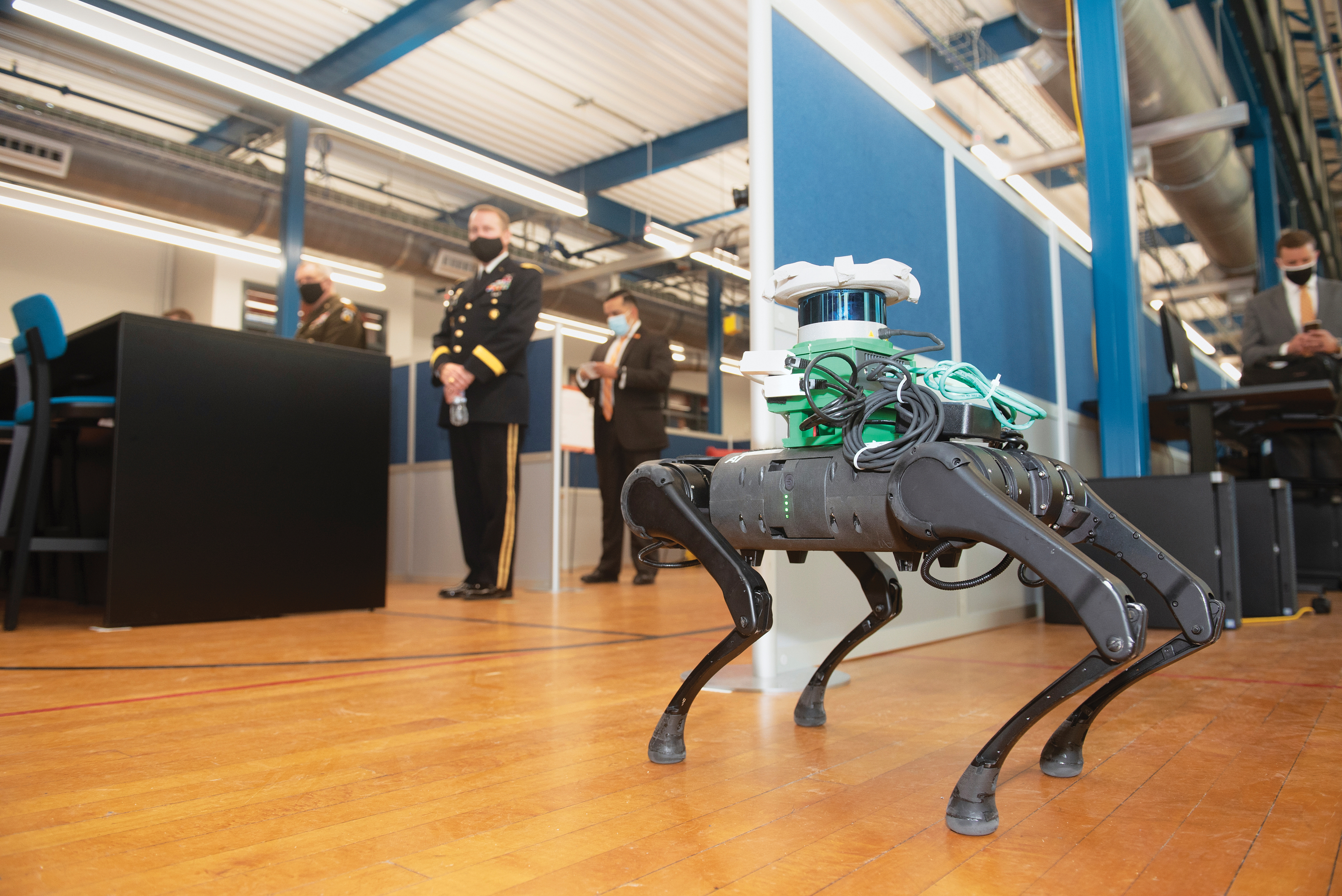Robots Are Roaming the Forty Acres in a New Research Program

For more than a century, robots have played a starring role in our visions of the future. Whether these sci-fi automatons would turn out to be our companions and servants—or our enemies and overlords—was always an open question. But one thing was certain: Robots would one day walk among us, for better or worse. While the past few decades have witnessed a remarkable increase in automation in the manufacturing
and logistics industries, most people still don’t encounter a physical robot in their day-to-day lives. For everyone on the Forty Acres, that’s about to change.
Starting this year, a multidisciplinary team of UT researchers will deploy a small network of delivery robots on campus to study the complicated dynamics of human-robot interactions in the real world. Funded with a five-year, $3.6 million grant from the National Science Foundation, the researchers will commandeer a fleet of robots that will ferry supplies around campus while collecting data that can be used to develop standards for safety, communication, and behavior for future robotic systems. Most of the robots used on campus will be modified versions of a dog-like quadrupedal robot—“Spot”— that was released by Boston Dynamics in 2016 and went viral in dance videos showcasing its agility.
“The basic [approach] in human-robot interaction research has been controlled experiments in a laboratory setting, which limits the types of scenarios you can study,” says Justin Hart, an assistant professor of practice with the College of Natural Sciences and one of the researchers in the program. “But when you have a robot going around campus—what we would call ‘in the wild’—there are opportunities to observe interactions you’d never see in a lab.”
The new program builds on research on human-AI partnerships conducted through UT’s Good Systems grand challenge that was launched in 2019. One of the projects in that grand challenge, called Living and Working With Robots, ran a series of studies that observed human-
robot interactions on campus in constrained real-world settings. For example, one of the studies Hart supervised was designed to understand how a human walking a Spot robot on a leash would change people’s perceptions about the safety and autonomy of the robot.
“We envision taking this idea to the next level with more autonomy and heavy components of data science and social science as well,” says Luis Sentis, the director of UT’s Human Centered Robotics Laboratory and the leader of the research program. “We want to explore what services these robots can provide in order to be truly useful to the community as a whole.”
The new fleet of robots that will start roaming UT this year will be heavily focused on delivering supplies across campus. Initially, the robots will carry supplies between the Anna Hiss Robotics Building and the GDC Computer Science Building, eventually expanding to deliver books from UT’s many libraries. The researchers are also programming them so that they can assist students and faculty with spoken directions or play fetch with passersby. The goal is to expose both robots and humans to a wide variety of interactions in order to better understand how those interactions can be improved, which will be critical to successfully integrating autonomous robots into the fabric of campus life in the future.
“One of the things that makes this in-the-wild research so exciting is that in the laboratory we have a lot of control over the situation even if we’re testing a brand-new technology,” Hart says. “But on campus we’re going to be able to see how real people engage with these systems, and it will often be wildly different from our expectations. It will be interactions we never even thought to model and that’s the big challenge.”
Robots that are used in factories or warehouses typically follow a tightly choreographed routine in an environment tailored to “their” needs. A robot arm assembling a car, for example, will perform the exact same movements around the clock and may be placed in a cage to prevent accidental injuries to human workers. Real life, however, is hardly ever so orderly, and any robots venturing out into the wild must constantly be ready to deal with the unexpected.
The number of scenarios the UT robots must grapple with on campus is staggering. For example, should robots navigate down shared pathways with humans, or would it be better to create dedicated lanes for robots? Do students like playing with the robots, or does it freak them out if one gets too close? Many of these questions don’t yet have answers—but over the next five years, the UT researchers aim to find them.

While Hart says that he has “literally never seen a person have a negative reaction to a quadruped robot,” some people are nonetheless nervous about these robot rovers on campus. A recent article about UT’s robot social experiment in Texas Monthly, for example, tells the reader, “It’s okay to fear the robot dogs coming to UT,” and appeals to a 2017 episode of the dystopian sci-fi show Black Mirror where a human is hunted by the same kind of quadruped robots that will be deployed on campus. Sentis understands why some people might be concerned about the team’s social experiment, which is why the researchers are placing a heavy emphasis on safety and privacy in their research.
As one of the largest and most well-funded studies on human interactions with robots embedded in their community, the UT researchers have an opportunity to play a central role in developing the standards that will guide the deployment of robots in the real world in the not-so-distant future. Already, robots are being deployed as supplementary security at shopping malls, inventory managers at supermarkets, and search-and-rescue guides in disaster areas. The problem is we still don’t really know much about how people perceive and interact with these robots when they encounter them in their daily lives. Sentis hopes the team’s research will usher in a future where robots can be intentionally programmed with the needs and expectations of humans in mind.
“We have a lot of extra measures on safety because the community wants assurance about the safety of the robots,” Sentis says. “Something that we can never lose sight of is that the most important thing is that robots must serve people and their communities.”
CREDITS: Chad Tomlinson, photos courtesy Boston Dynamics; UT/Birzer Photo





